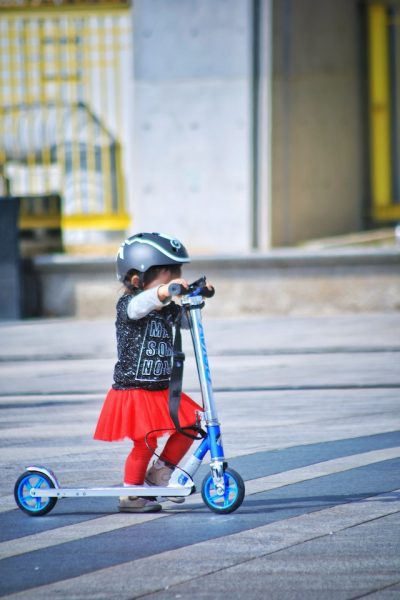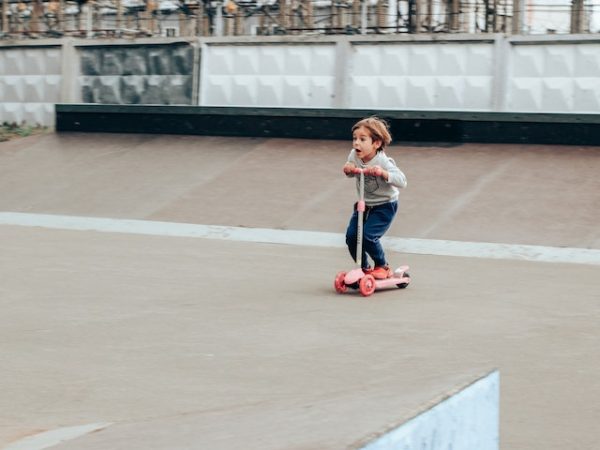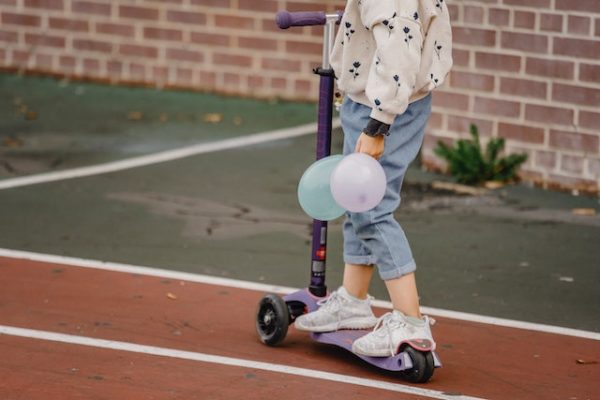As parents and caregivers, we understand the joy a simple scooter ride can bring to our little ones. At FamilyHype, we want to ensure our readers are empowered to keep their children safe and secure while they have fun. That’s why we’ve put together this comprehensive guide on scooter safety for the little ones.
This guide will not only help you choose age-appropriate scooters but also emphasize the necessity of protective gear. We’ll equip you with the knowledge of basic scooting skills to teach your toddler, provide tips on supervision, and discuss setting boundaries for safe scooting. Plus, we’ll highlight the importance of regular maintenance, encourage safe play, and remind you to encourage regular breaks during playtime.
We want to ensure our readers are aware of the risks associated with these two-wheeled companions, and how to prepare and plan around them. As parents, we play a crucial role in ensuring that our children are safe, and this guide aims to empower us to do just that. Let’s ensure our kids have fun while we keep them safe.
We’d love to hear your feedback, so please feel free to share your thoughts and experiences with us. Other resources, like the importance of helmets, child-proofing the area, and the importance of teaching children how to ride their scooties properly, are available from organizations such as the American Academy of Pediatrics and the National Safety Council.

Key Takeaways
- Choosing age-appropriate rides and emphasizing the importance of protective gear is crucial for your toddler’s harmlessness.
- Supervising playtime, inspecting the play area for hazards, and allowing self-exploration with guidance are important for safe riding.
- Setting boundaries for scooting, including customization, traffic awareness, designated scooting areas, time limits, and wearing protective gear, helps ensure that your toddler is safe and protected.
- Regular maintenance, checking nuts, bolts, handlebars, and wheels, and upgrading parts can enhance protection and enjoyment.
Importance Of Age-Appropriate Scooters

You’ve got to remember, it’s crucial to choose a scooter that’s age-appropriate for your little one, as it can significantly enhance both their harmlessness and joy while riding.
We understand your concern. You want a two-wheeled companion that’s durable and can withstand the energetic play of young kids. Durability isn’t just about lasting longer, it’s about providing a stable ride for your child, helping them develop and improve their toddler balance.
Choosing one with easy-grip handles and a wide base can make a world of difference. It gives your child the confidence to explore and have fun safely.
We know your child’s well-being is your foremost concern, and we’re here to support you.
The next thing to consider is the importance of wearing protective gear, a vital aspect we’ll delve into next.
Importance Of Wearing Protective Gear
Donning the right protective gear is crucial; it’s not just about looking cool, it’s about shielding your child from potential harm. We understand that no parent would ever want to see their little one hurt, so we always stress the importance of gear fitting.
A well-fitted helmet, and knee, and elbow pads are essential to ensure every ride is safe and enjoyable. Helmet selection is another crucial factor. A helmet that’s too loose or too tight won’t provide the necessary protection. We recommend choosing a helmet designed specifically for little kids, with adjustable straps for a comfortable and secure fit.
Remember, every ride should be a balanced mix of fun and harmlessness. Now, let’s move on to how we can instill basic scooting skills in our little ones, ensuring they ride with confidence and caution.
Teaching Basic Skills

Now that we’ve got the gear sorted, it’s time to dive into the meat of the matter – helping our kids master the art of balanced and careful riding.
Scooting posture and speed control are the crux of safe riding. Here are some key points to remember:
- Helping them find their balance, starting with getting on and off safely.
- Teach them the correct scooting posture, like keeping their head up and not leaning overly forward.
- Introducing speed control, ensuring they understand the importance of not going too fast.
- Making turns and stopping – are two crucial skills to avoid accidents.
By following these guidelines, we can foster a safe and enjoyable scooting experience.
Next, we’ll explore how to make supervising playtime both fun and safe.
Supervising Playtime
Keeping a watchful eye on your child as they master scooting can be an art in itself, blending elements of protection, guidance, and yes, a dash of playfulness. This is where toddler supervision techniques come into play.
It’s important to ensure your child’s harmlessness without dampening their adventurous spirit. Start by inspecting the play area, checking for any potential hazards like sharp corners or slippery surfaces. Encourage them, guide them, but let them explore.
Remember, your role is not just to prevent them from falling but also to teach them how to get back up. With a balance of careful supervision and allowing self-exploration, we can create a safe scooting environment for our children.
Now, let’s head into ensuring these little explorers know their boundaries while scooting.
Setting Boundaries
Just as important as playtime is, it’s equally vital to lay down clear-cut boundaries for our young adventurers during their scooting escapades. Scooting is not just about fun, it’s about growing responsibly. They need to have a clear understanding of where they can scoot and what they can do.
- Customization is a great way to make the ride appealing, but also a safe piece of equipment.
- Traffic awareness is paramount; teaching them to look both ways before crossing is essential.
- Designating scooting areas within safe zones promotes a sense of responsibility.
- Establishing time limits on scooting can prevent fatigue-induced accidents.
- Reiterate the importance of always wearing a helmet and protective gear.
As we navigate these boundaries, let’s not forget the importance of embracing the great outdoors, while keeping protection at the forefront.
Next, we’ll explore how to handle precautions for outdoor scooting.
Precautions For Outdoor Riding
Embracing the thrill of outdoor scooting demands careful consideration of certain precautions, to ensure our young thrill-seekers are well-protected while they explore their world. The first protocol is customization. Adjusting the handles and brakes to fit the child’s size isn’t just about comfort, it’s a necessity for your child’s protection. Properly sized rides give our little kids more control and reduce the risk of accidents.
Weather considerations are another key factor. Though scooting in the rain may seem like an adventure, slippery conditions can lead to falls. We must teach our little ones the importance of checking the weather before heading out. Also, using brightly colored scooters or reflective stickers can increase visibility during foggy or dark conditions.
Moving forward, let’s discuss why regular maintenance goes hand-in-hand with these precautions to keep our children safe and sound.
Importance Of Regular Scooter Maintenance
Regular maintenance of your child’s ride isn’t something to overlook, as it plays a crucial role in their overall protection and enjoyment. It’s essential to frequently check the nuts, bolts, handlebars, and wheels, ensuring they’re secure and functioning properly. This can be easily done with a few basic maintenance tools, and trust us, it’s worth every minute spent.
If you notice wear and tear, don’t hesitate to invest in some important upgrades. A new pair of handle grips or a sturdy wheel replacement can significantly enhance harmlessness and performance, making your child’s scooting experience even more delightful.
Remember, our little ones depend on us to keep them safe. Regular maintenance not only ensures their ride is secure but also fosters a fun environment.
In our next discussion, we’ll explore how to cultivate this fun through the promotion of safe play habits.
Encouraging Safe Play
Teaching your kids the importance of playing safely can be a real game-changer, not just for their physical well-being, but also for their confidence and self-esteem. As caregivers, we’re responsible for guiding them through the playful learning journey, creating an environment that is both fun and secure.
It involves constant risk assessment, ensuring that their play space is free from hazards that could cause injuries. We must also teach them the importance of wearing protective gear while riding their two-wheeled companions. This way, they understand that harmlessness is not a hindrance to fun but a prerequisite.
Now that we’ve talked about encouraging safe play, let’s move on to discussing the importance of regular breaks during playtime and how it contributes to their overall well-being.
Importance Of Regular Breaks During Playtime
Don’t underestimate the power of a good rest – it’s just as important as the play itself. Yes, we want our children to have fun and enjoy their playing time, but we also need to ensure they’re taking adequate rest intervals.
Remember, their little bodies are still growing and require regular breaks to prevent exhaustion.
Hydration’s importance cannot be overstated during these breaks. Encourage your child to drink plenty of water to stay refreshed and energized. This not only prevents dehydration but also helps in maintaining concentration and balance, which are crucial for their overall protection.
As we guide our little ones through this enjoyable journey, it’s our responsibility as parents to provide a balanced routine of play, rest, and hydration.
Now, let’s explore further the pivotal role we parents play in ensuring that they are safe.
Role Of Parents In Ensuring Safety
As a parent, you’re in the driver’s seat when it comes to setting boundaries and establishing rules for your child’s outdoor activities. Your role is paramount in ensuring harmlessness while they ride their two-wheeled companion.
Parental education is key in risk communication. This involves teaching your kids about the importance of being safe, the potential dangers, and how to navigate them.
- You’ll need to teach your child to always wear their helmet and protective gear.
- Encourage them to take regular breaks and hydrate to prevent fatigue-related accidents.
- Constant supervision, especially for younger kids, is crucial. You can’t afford to take your eyes off them for a minute.
Remember, your vigilance and guidance can make all the difference. Let’s keep our little ones safe and sound while they have fun!
Conclusion
We know, as parents, ensuring our toddlers’ protection while they have fun is our top priority. That’s why FamilyHype recommends getting age-appropriate scooters, insisting on protective gear, and teaching basic skills.
We must set boundaries, maintain their rides, and encourage safe play. Regular breaks are key, and we are the frontline of their harmlessness.
Let’s make scooting safe and enjoyable for our little ones. At FamilyHype, we believe that protection, education, and fun can all coexist.
We would love to hear your feedback on how to make scooting even safer and more enjoyable for our little ones. Share your thoughts with us in the comments below!
Frequently Asked Questions (FAQs):
How Can You Be Away From Danger When Riding A Scooter?
To ensure that they are away from danger, it is crucial to prioritize the protection of riders, especially young children. The first priority is to provide a properly sized vehicle with an appropriately adjusted handlebar and deck size to minimize the risk of a child falling and getting injuries. Alongside this, it is essential to equip children with protective gear such as a properly fitted helmet, knee pads, and other accessories to protect against common injuries, particularly head or brain injuries. Investing in quality protective gear is crucial as it meets safety standards set by organizations like the Consumer Protection Safety Commission, unlike cheap protective gear. Finally, teaching children cautionary rules, such as riding responsibly, being aware of their surroundings, and understanding the potential risks of accidents, helps protect kids and prevent child injuries while enjoying the benefits of enjoyable riding.
What Are The Injuries That Kids Can Get When Riding This Two-Wheeled Vehicle?
Injuries of kids can include head injuries or even brain injuries, which are a significant concern. To prevent such injuries, it is crucial to ensure children wear protective equipment, such as helmets, specifically designed for scooter riding. Additionally, teaching children the importance of wearing protective gear, including bicycle helmets and wrist gloves, and practicing safe riding habits can help reduce the risk of injuries while enjoying the benefits of scooter riding.
Does A Toddler Need A Helmet For A Scooter?
Yes, it is important for a toddler to wear a helmet to protect the child from head injury. This measure applies to most kids’ models of scooters, ensuring that the child wears a helmet, which is essential for their health and safety.
What Size Helmet Does A 2-Year-Old Need?
A 2-year-old typically needs a helmet with a size that ranges from 48 to 52 centimeters, but it is crucial to measure the child’s head circumference to ensure the right fit and provide adequate protection. As much as it’s important to teach children some tips on improving their motor skills, giving them proper protection along the process is vital every time a child rides.
What Age Should A Child Have Their Own Scooter?
The appropriate age for a child can vary based on their individual development and coordination skills. Generally, children around 3 to 5 years old can start learning to ride it with proper supervision and guidance.
What Age Is Perfect For Children To Use EScooters?
Their harmlessness depends on various factors, including the child’s age, riding skills, and the ride’s features. E-scooters are generally recommended for older children, usually around 8 to 10 years old or older, who have developed the necessary coordination and understanding of road rules.
Are EScooters Generally Harmless?
E-scooters can be safe when used responsibly and following guidelines such as wearing appropriate protective gear, riding in designated areas, and adhering to traffic rules even on bike lanes. However, it is important to consider factors like the child’s age, experience, and the specific model to ensure safe usage. For maximum protection, look for a helmet certified by the Consumer Product Safety Commission. Also, scooter riders should wear elbow pads, wrist guards, knee pads, and closed-toe shoes before leaving home to ride.
Should I Get My Child Their Own EScooter?
Whether or not to get your child an e-scooter depends on factors such as age, maturity level, and ability to handle it responsibly. It is essential to assess their readiness, provide proper supervision, and ensure they follow cautionary guidelines to make an informed decision.
What Causes Scooter Fires?
Fires can be caused by various factors, including faulty or damaged electrical components, improper charging, or using incompatible chargers. Following manufacturer guidelines, using original equipment, and practicing safe charging habits can help prevent fires.
Which Brake Is Safest To Use In These Two-Wheeled Vehicles?
The rear brake is generally considered the safest to use as it provides better control and stability during braking. It allows the rider to evenly distribute the braking force and maintain better balance, reducing the risk of accidents or skidding.
DISCLAIMER (IMPORTANT): This information (including all text, images, audio, or other formats on FamilyHype.com) is not intended to be a substitute for informed professional advice, diagnosis, endorsement or treatment. You should not take any action or avoid taking action without consulting a qualified professional. Always seek the advice of your physician or other qualified health provider with any questions about medical conditions. Do not disregard professional medical advice or delay seeking advice or treatment because of something you have read here a FamilyHype.com.